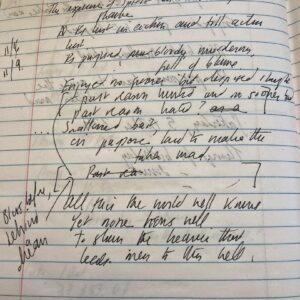I’m always a bit in awe of poems where the rhymes intertwine. By “intertwine,” I mean that there’s rhyme-linkage between stanzas. (We could just as well call it interlocking or interlacing rhyme.)
Of course the locus classicus for intertwining rhymes is the terza rima that Dante invented in The Divine Comedy. Take just the beginning of the Inferno:
Nel messo del cammin de nostra vita mi ritrovai per una selva oscura che la diritta via era smarrita. Ah quanto a dir qual era e cosa dura esta selva selvaggia e aspra e forte che nel pensier rinova la paura! Tant' e amara che poco e piu morte: ma per trattar del ben ch'io vi trovai, diro dell'altre cose ch'i' v'ho scorte.
Even if you can’t understand the Italian, you can see that we’ve got ABA, BCB, CDC…which will continue throughout the entire three volumes of the Commedia.
*
And while I’m thinking of three-line intertwined stanzas, I naturally turn to the villanelle. Here the rule is: five stanzas with ABA rhyming, then a final quatrain of ABBA. Plus another rule: there are two refrains repeated throughout, which then hook up as the poem’s final two lines. Take Edward Arlington Robinson’s “The House on the Hill” (in his 1927 collection The Children of the Night):
They are all gone away, The House is shut and still, There is nothing more to say. Through broken walls and gray The winds blow bleak and shrill: They are all gone away. Nor is there one to-day To speak them good or ill: There is nothing more to say. Why is it then we stray Around that sunken sill? They are all gone away, And our poor fancy-play For them is wasted skill: There is nothing more to say. There is ruin and decay In the House on the Hill: They are all gone away, There is nothing more to say.
*
Then there’s the intriguing ghazal form. Here’s how poets.org describes it:
“The ghazal is composed of a minimum of five couplets—and typically no more than fifteen—that are structurally, thematically, and emotionally autonomous. Each line of the poem must be of the same length, though meter is not imposed in English. The first couplet introduces a scheme, made up of a rhyme followed by a refrain. Subsequent couplets pick up the same scheme in the second line only, repeating the refrain and rhyming the second line with both lines of the first stanza. The final couplet usually includes…the poet’s own name or a derivation of its meaning.… The form has roots in seventh-century Arabia, and gained prominence in the thirteenth- and fourteenth-century thanks to such Persian poets as Rumi and Hafiz.”
An engaging recent example in English is “Even the Rain,” by Agha Shahid Ali (1949-2001), from his collection Call Me Ishmael Tonight. Its thirteen stanzas are too much to quote in full, but here’s a selection, including the first and final verses:
What will suffice for a true-love knot? Even the rain? But he has bought grief’s lottery, bought even the rain.… Drought was over. Where was I? Drinks were on the house. For mixers, my love, you’d poured—what?—even the rain.… After the bones—those flowers—this was found in the urn: The lost river, ashes from the ghat, even the rain. What was I to prophesy if not the end of the world? A salt pillar for the lonely lot, even the rain.… New York belongs at daybreak to only me, just me— To make this claim Memory’s brought even the rain. They’ve found the knife that killed you, but whose prints are these? No one has such small hands, Shahid, not even the rain.
(Of course I can’t let these lines go without noting the fun biblical pun in “A salt pillar for the lonely lot.”)
*
Finally, I have to turn to Robert Frost’s “Stopping by Woods on a Snowy Evening.” Its interlaced rhymes don’t follow any standard form like the villanelle or the ghazal. But its rhyming delightfully interlinks each verse to its predecessor, in an AABA, BBCB, CCDC, DDDD pattern:
Whose woods these are I think I know. His house is in the village though; He will not see me stopping here To watch his woods fill up with snow. My little horse must think it queer To stop without a farmhouse near Between the woods and frozen lake The darkest evening of the year. He gives his harness bells a shake To ask if there is some mistake. The only other sound's the sweep Of easy wind and downy flake. The woods are lovely, dark and deep. But I have promises to keep, And miles to go before I sleep, And miles to go before I sleep. *
A post on interlocking rhymes should end by locking back to its beginning—in this case, to terza rima. Let’s see a bit of it in, say, Shelley’s twenty-five-stanza “Ode to the West Wind,” which ends:
Drive my dead thoughts over the universe Like wither'd leaves to quicken a new birth! And, by the incantation of this verse, Scatter, as from an unextinguish'd hearth Ashes and sparks, my words among mankind! Be through my lips to unawaken'd earth The trumpet of a prophecy! O Wind, If Winter comes, can Spring be far behind?
Peggy Rosenthal has a PhD in English Literature. Her first published book was Words and Values, a close reading of popular language. Since then she has published widely on the spirituality of poetry, in periodicals such as America, The Christian Century, and Image, and in books that can be found here.





